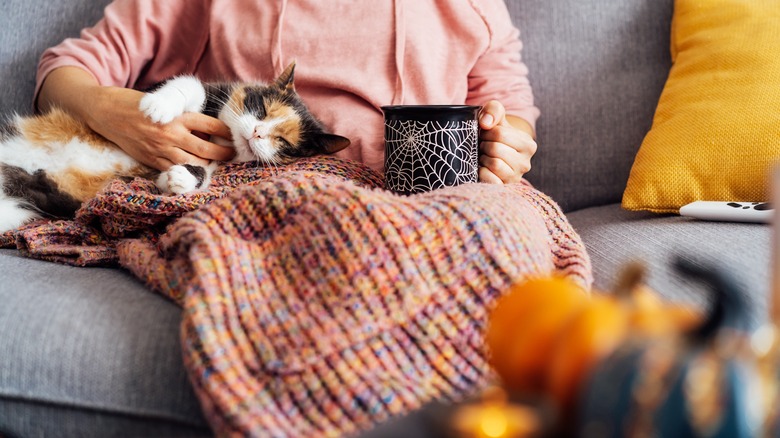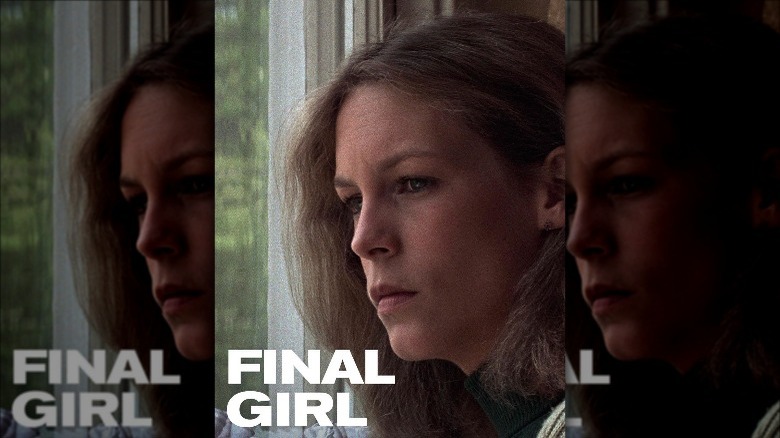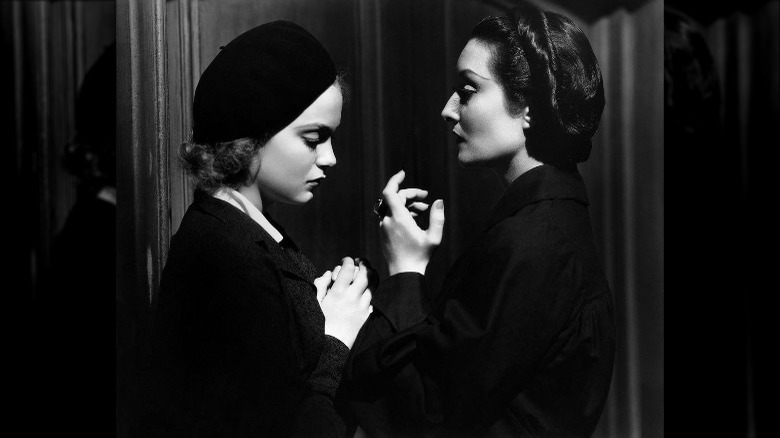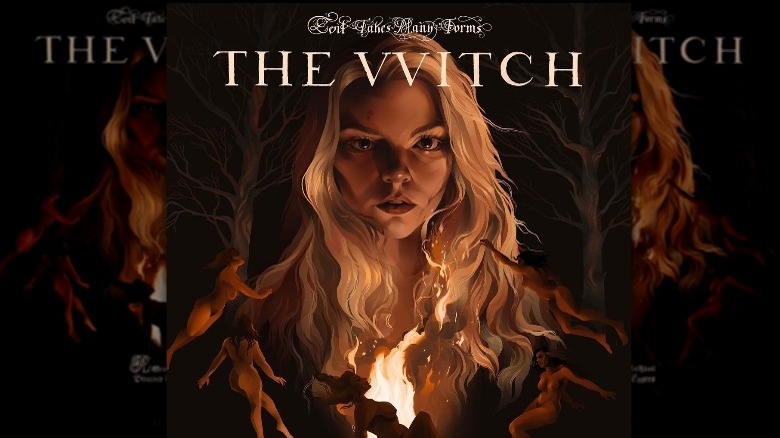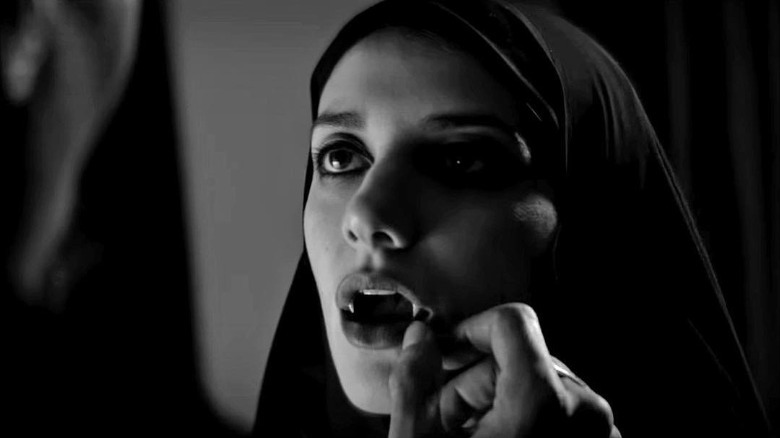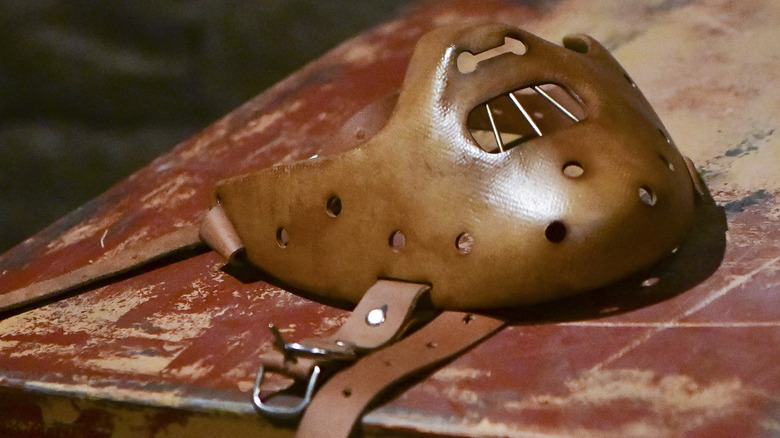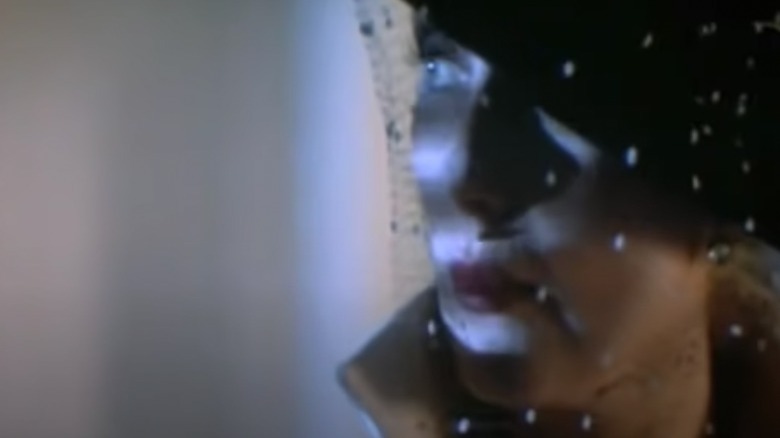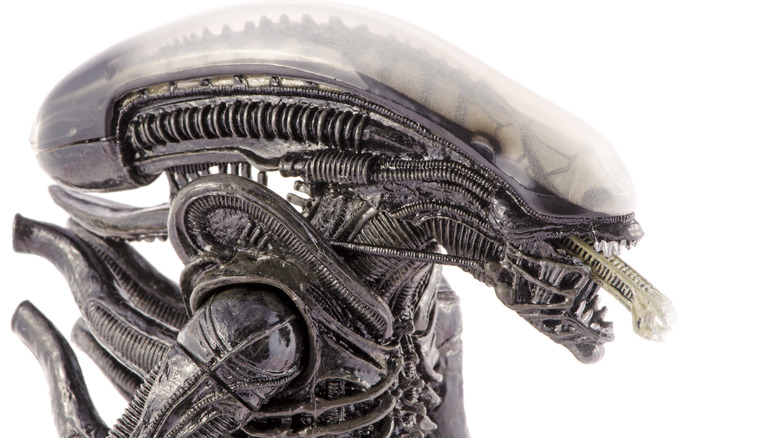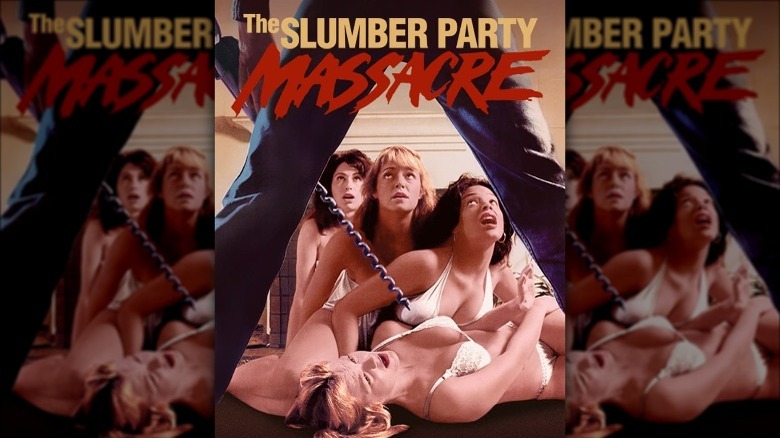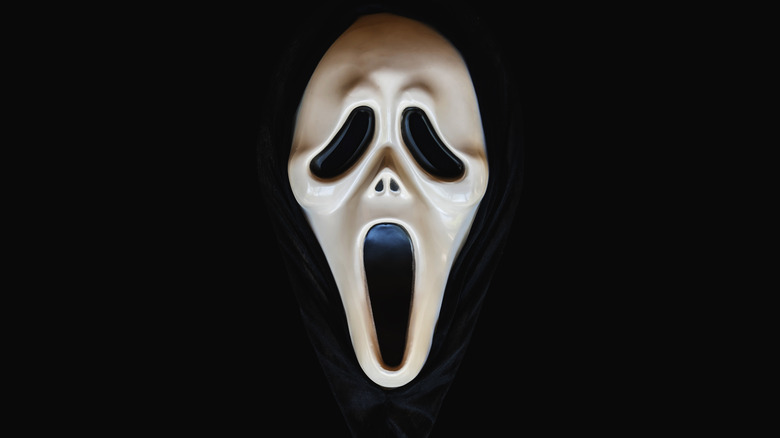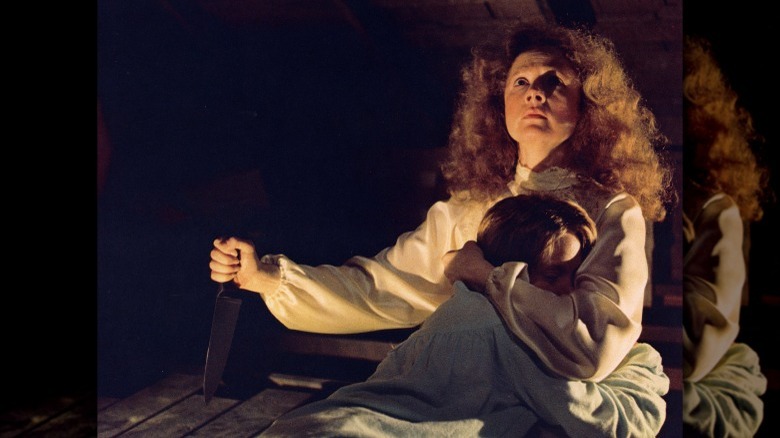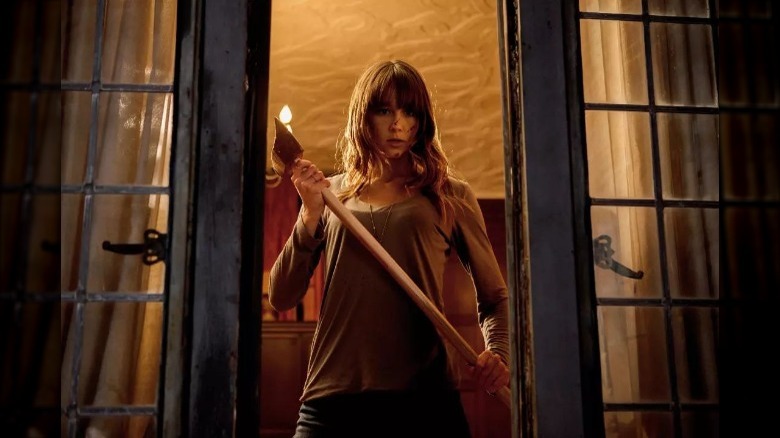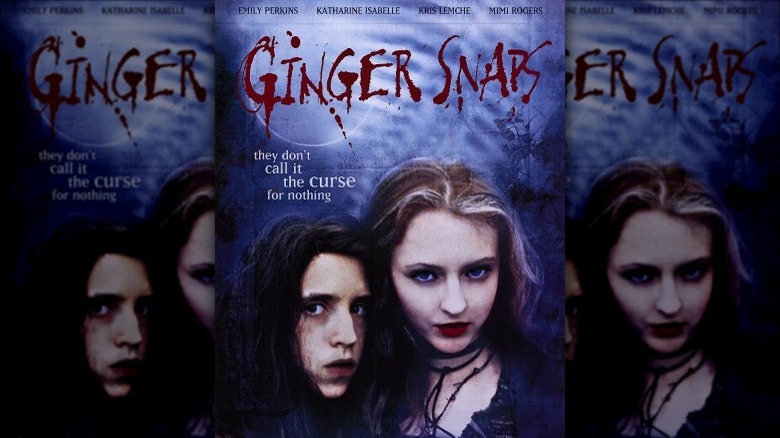Female Empowerment Films To Watch This Halloween
We may receive a commission on purchases made from links.
Crouching in the shrouds of shadows in an old abandoned warehouse, a woman waits covered in glistening drops of sweat and tears as a manic chaser searches relentlessly for her. Her meticulously styled bombshell curls have been jostled out of place, and her sheer floral blouse has been ripped in seven places, revealing her scraped and bruised skin from a 30-minute game of cat and mouse in the forest. We begin to think the exquisite damsel in distress's moments is numbered just as — wait! A swashbuckling male hero enters the scene. With his natural brute strength and unwavering testosterone, he defeats the woman's perpetrator single-handedly, but not before her battered and forlorn blouse rips open for us to catch a glimpse of her topless.
If this cliché movie scenario sounds familiar, that's probably because it is. Almost every scary Halloween film in history — aside from a select few — has long represented women as, well, objects, per Google. Prominently in most older horror or spooky movies, a woman is never safe until a man rescues her, and this goes for plenty of other genres as well. Furthermore, it wasn't until the sexual revolution of the 1960s and '70s that women began to break out of this "please rescue me" stereotype. But even then, these female protagonists weren't completely let off the hook.
The final girl trope
American media and popular cultural studies student Britt Rhuart explains that even in films like "Halloween," where we see the strong, independent female lead Laurie Strode (played by Jamie Lee Curtis) kick some major Michael Myers butt, she's still left with years of trauma and never actually recovers from her run-ins with the infamous killer (via BG Falcon Media). Because — insert sarcasm — how could a woman ever move on from such a thing? Laurie is defined in horror popular culture as a "final girl," meaning that one girl or woman is left standing and typically faces the killer on her own.
Despite her PTSD and ultimately winding up in an asylum, Laurie Strode was a great start to representing women in film for the better. "Laurie is the ultimate slasher scream queen. The character provides a true form of a great horror heroine. She is selfless, independent, and strong," Rhuart explains.
That being said, there are actually plenty of options to stream this fall that don't present as many flaws with their representation of women. If you're tired of the stereotypical "woman role" during Halloween, we're here for you. We've compiled a list of some of the best films that we think highlight women in a better light for the ultimate feminine Halloween movie-thon experience. Get ready to feel empowered, ladies.
Dracula's Daughter
Hitting the silver screen in 1936, per IMDb, "Dracula's Daughter" details the tribulations of fictional character Countess Marya Zaleska (played by Gloria Holden). According to a 1936 report in The New York Times, Zaleska, upon learning about the death of her father, Count Dracula, hopes to break free of her vampiric curse. She soon discovers that, to her dismay, her thirst for blood remains, and she turns to the aid of psychiatrist Dr. Jeffrey Garth (Otto Kruger) for help. When her psychiatry theory begins to prove itself faulty, Zaleska gives in to the curse and plots to lure Garth to Transylvania in order to ensnare him as her eternal companion.
As noted by Horror Homeroom, the underrated and often overlooked Halloween classic was ahead of its time in multiple ways. The film was loosely based on the 1872 British gothic novella "Carmilla" by Jospeh Sheridan Le Fanu, which is often reported to be the first British fiction novel to detail lesbian relationships (via the AFI Catalog). Moreover, aside from a woman taking the reins from an iconic male horror character in "Dracula's Daughter," certain queer undertones can be spotted throughout the film — something that was unheard of in 1930s American cinema. The film was even an immense inspiration for the legendary vampire fiction author Anne Rice (via Twitter).
The Witch
In 2015, per IMDb, audiences globally were metaphorically captured and transported through a visual time capsule with A24's "The Witch." Noted as a "folk horror film that does not rely on gore to terrify the audience" by The Guardian, the film depicts the issues faced by a 1600s Puritan family after being forced to leave their village on the accusation of their daughter's (Anya Taylor-Joy) witchcraft. Many film critics praised the movie's visual style — specifically its use of lighting and cinematography, according to Rotten Tomatoes. Aside from its visible artistry, the masters behind the making of the film went above and beyond to secure its authenticity, notably through its historical dialogue.
On top of being particularly aesthetic to watch, Wired describes the movie as "wildly feminist" as well. In fact, "The Witch" director Robert Eggers explained to Bustle that his belief regarding the Salem witch trials being a way to control the power of women highly influenced the film. "When someone called you a witch, it wasn't just that they're intimidated by you as a powerful woman; there is some of that for sure," Eggers says. "But it is also that you're actually a fairy tale witch capable of doing all of the horrific, primal, terrible things that the witch does in this film. The fact that that was the belief just shows you how intense it was. That's actually more sexist, it makes the fear of female power even greater than if it were a conspiracy where these people didn't believe in witches."
A Girl Walks Home Alone at Night
Written and directed by Ana Lily Amirpour, "A Girl Walks Home Alone at Night" is a 2014 Iranian vampire Western film shot in the Persian language (via IMDb). Taking place in a fictional town in Iran called Bad City, the movie follows the tale of a chador-clad young female vampire (played by Sheila Vand) who prefers to travel alone after dark on a skateboard. The Girl, who remains nameless in the film, stalks the shadowy dark streets of Bad City at night preying on men — that is, until she meets Arash.
What's more, an article published in (Un)common Horrors notes that the young girl's desire to shut down patriarchal norms in her city becomes evident very early on. When we are first introduced to The Girl, we're presented with an image of submission as the veiled character is easily persuaded to follow an unsavory man home. Soon, however, our point of view changes as we learn that The Girl is the one to be feared rather than to be feared for. Foreign Policy Magazine adds that the film completely slashes through typical Iranian film censorship. It's noted that the chador The Girl dons, which is a "culturally specific Iranian veil," is meant as a metaphorical symbol to challenge American viewers' perception of Muslim women.
The Silence of the Lambs
Based on Todd Harris' 1988 novel, "The Silence of the Lambs," the 1991 film adaptation stars Jodie Foster as Clarice Starling, Anthony Hopkins as Dr. Hannibal Lecter, and Ted Levine as "Buffalo Bill," per IMDb. Recognized as one of the most iconic horror films of all time, "The Silence of the Lambs" is the only horror movie in history to win the academy award for best picture (via CBR). We know most of you know the story, but to recap, the film closely follows a young female FBI trainee (Foster) who is tracking down a serial killer with the help of the imprisoned-but-brilliant cannibalistic Dr. Lecter.
The BBC explains why Foster's role as Clarice was historical and way ahead of its time, noting that she is a professional and doesn't rely on others or luck. She runs her own story without needing men and without needing outside help generally. Furthermore, despite all of Starling's advances by her male counterparts and superiors, she isn't phased. She valiantly stands her ground in a male-dominated career and handles Lecter's jabs with ease as she poignantly matches his intelligence.
The Hunger
The 1983 film "The Hunger" stars David Bowie, Susan Sarandon, and Catherine Denueve (via IMDb). According to Louder Sound, the film was a major box-office flop, but that hasn't stopped it from reaching cult-classic status over the years. In fact, Stevie Nicks went so far as to credit "The Hunger" as one of her favorite moments of Bowie's career, calling the film "just creepy and strange and amazingly beautiful," per Rolling Stone.
The film illustrates the tale of an intriguing love triangle between a doctor who specializes in sleep and aging research (Sarandon) and a deadly vampire couple (Bowie and Deneuve). Denueve's character, Miriam Blaylock, is a force of nature who is depicted slaying victims all the way back to ancient Egypt. Blaylock is charmingly cool and devastatingly hypnotic, and she oozes sexuality. The Dissolve explains that vampire women in film, historically, are nothing to be reckoned with. In "The Hunger" specifically, the women are the characters who wield all the power, so much so that Blaylock easily dismisses Bowie's aging character, her lover of 100 years, to begin a new relationship with a woman. Just as Sarandon states in the film, "She's that kind of a woman. She's European."
Alien
Ridley Scott's "Alien," which debuted in 1979, sparked the beginning of a film franchise that viewers adore to this very day, per IMDb. The story follows the expedition of the crew on a commercial space tug who run into trouble when they find themselves up against a deadly extraterrestrial. Film stars Tom Skerritt, Sigourney Weaver, Veronica Cartwright, Harry Dean Stanton, John Hurt, Ian Holm, and Yaphet Kotto make up an iconic team as anyone watching the film tries to keep their cool in some of the movie's most infamous horror scenes.
Notably, Sigourney Weaver's leading role as Ellen Ripley is hard to ignore when it comes to horror's most powerful females (via MovieWeb). A lot of Weaver's prevalence as such a legendary character comes from "Alien" not only being a horror-slash-sci-fi-film but also an action one — a predominantly male-dominated genre before the film was released. In fact, The Guardian declares Ellen Ripley as "the first action heroine," sealing Weaver's performance as the boost Hollywood women needed.
As sequels were made and the franchise produced more and more films, Weaver's female empowerment legacy never seemed to fade. "'Alien: Covenant' is interesting for the way it puts women to the margin of everything throughout the film — until the final sequence," José Arroyo, principal teaching fellow in film studies at Warwick University, tells Vice regarding the 2017 sequel. "But, at that point, the feminist element of the franchise is then very clearly reinforced."
The Slumber Party Massacre
"The Slumber Party Massacre" is a 1982 slasher film written by Rita Mae Brown that stars Michelle Michaels, Robin Stille, and Michael Villella, per IMDb. Often overlooked as a stereotypical slasher that features nude women and a gory murder spree, the deeper meaning of the film is actually concealed with a lot of women-in-horror-focused satire. The plot is exactly what you'd imagine: a group of high school girls gathers at protagonist Trish Deveraux's house for a cliché '80s slumber party, all unaware that a power tool-wielding killer is terrorizing the town.
But what is so empowering about that? A group of teens scantily dressed in lingerie and being slaughtered off one by one hardly sounds like an inspiring tale, however, this is kind of the point. In fact, the film was written by Rita Mae Brown, a well-known feminist author and activist, according to Xtra. As explained by Rue Morgue, the film goes above and beyond to deliver us exactly what you'd expect from a typical slasher film — only this time, it's to the point of almost mocking us. Everything from the hyper-sexualized opening shower scene to the killer's objectifying predator dialogue was conscientious in Brown's writing.
And of course, this is all tied together for an ending we aren't expecting. "At the end of the movie, a woman who has miraculously survived the carnage breaks [the killer's] drill in half. That's feminism for you, and symbolism too," writes film critic Janet Maslin for The New York Times.
Scream
The original "Scream" (1996), per IMDb, has withstood the test of time. Five sequels later and a sixth on the way (via IMDb), "Scream" delivers all the '90s nostalgia we could ever ask for. It stars Neve Campbell as high school student Sidney Prescott, who becomes the mysterious target of a "ghost-face" masked killer. The film was unlike anything else at the time of its release due to its blatant discussions and satirical dialogue on other slasher movies.
The Mary Sue explains that "Scream" was always meant to be revolutionary, never just another random film in the horror genre. Over the course of the past 25 years, the "Scream" heroines have — time and time again — proven themselves as outspoken, assertive, capable, and courageous — arguably the recipe for a strong woman. The slew of women in all five films can hold their own, and that includes everyone from the "dumb-blonde" stereotype to the cut-throat weather girl on TV.
From the beginning of the franchise, Sidney discloses her distaste for horror films because of their sexist nature. "They're all the same," she says. "Some stupid killer stalking some big-breasted girl who can't act who is always running up the stairs when she should be running out the front door? It's insulting" (via IMDb).
Carrie
"'Carrie' is largely about how women find their own channels of power, but also what men fear about women and women's sexuality," writes "Carrie" author Stephen King in his book "Danse Macabre." "Writing the book in 1973 and only three years out of college, I was fully aware of what Women's Liberation implied for me and others of my sex." Three years later, "Carrie" would become a full-length motion picture to hit the big screen, per IMDb.
1976's "Carrie" follows closely along with King's book, sticking to the main plot of a 16-year-old outcast girl (Sissy Spacek) who is continuously ridiculed and bullied at school. Carrie is not just any typical girl, however; she processes the gift of telekinesis. Unfortunately for the fate of Carrie, these powers are not a gift in her mother's eyes. Just as Carrie's first prom goes awry, her mother's warnings ring throughout her head, and the tormenting voices of her bullies and of those who failed to recognize her as a person with feelings soon begin to sweep in. After Carrie is oppressed, humiliated, and tormented, she strikes back, and the entire school suffers — a theme that has stuck in the hearts of feminists for over 45 years.
You're Next
When watching the trailer for "You're Next," there's absolutely nothing in the clip's two minutes and twelve seconds that even remotely hints at the ultimate feminine storm that you're about to be blown away by (via YouTube). According to Game Rant, however, this is just one of the many surprises of the 2011 low-budget slasher film, and in the years following its initial release, "You're Next" has garnered an extensive cult following. The movie depicts an estranged family gathering together for a reunion — only to soon to fall under attack by a group of masked murderers.
At the beginning of the film, Erin (Sharni Vinson) is a quiet, laid-back character. She's the girlfriend of one of the brothers in the family, and we're given the impression that she isn't too important. However, as the movie progresses, we get to see more and more of who Erin really is. "She is the only one who reacts to the situation with some kind of sense, rather than senseless wailing. While the others freak out, she starts locking down the house, gathering weapons from the kitchen drawers, and setting up traps," horror author Joanna Parypinsk writes on her blog. Soon, it's revealed that Erin was raised on a survivalist compound in the Australian outback. The result? Some horrified killers who are in for the shock of their lives.
Ginger Snaps
2000s Canadian horror film "Ginger Snaps" stars Emily Perkins and Katharine Isabelle as Brigitte and Ginger Fitzgerald — two sisters sharing their morbid obsession with death, per IMDb. While out after dark, Ginger experiences menstruation for the first time, causing a werewolf to pick up on her scent and bite her. She then begins a transformation that starts to test her and her sister's relationship.
"I think it is definitely possible to make feminist horror movies and I think we have proven that with all three Ginger Snaps films," says Paula Devonshire, producer of "Ginger Snaps Unleashed" and "Ginger Snaps Back" (via Menstrual Monsters: the Reception of the Ginger Snaps Cult Horror Franchise). Moreover, the film challenges the fact that werewolves are almost always historically associated with males. Logically, because werewolves transform once a month during a full moon, it only makes sense that this would correlate with a female's monthly menstrual cycle — something that has been overlooked for centuries since the first mention of werewolves in the dawns of time, per History.
The moon is depicted all the way back to ancient times as a prominent feminine symbol. It is said to represent ovulation under a full moon and menstruation under a new moon (via Secret Sisterhood). "Ginger Snaps" took a strong grasp of this concept and ran with it, seemingly asking the audience, "Why has no one else ever thought of this before?"
